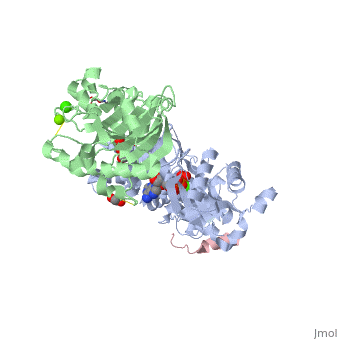Wiskott-Aldrich syndrome protein
From Proteopedia
(Difference between revisions)
| Line 1: | Line 1: | ||
| - | <StructureSection load=' | + | <StructureSection load='2a3z' size='340' side='right' caption='Human WASP WH2 domain complex with α-actin and DNAse I (PDB code [[2a3z]])' scene=''> |
'''Wiskott-Aldrich syndrome protein''' (WASP) is involved in nucleating of new F-actin. In the autoinhibited form of WASP a region of the N-terminal interacts with a region of its C-terminal. This interaction is disrupted by CDC42 and phosphatidylinositol 4,5-bisphosphate (PIP2) resulting in the active WASP. '''N-WASP''' (Neural WASP) belongs to the WASP family of proteins. Human N-WASP stimulates the actin-nucleating activity. N-WASP induces actin polymerization in the Shigella bacterium. This bacterium causes dysentery. | '''Wiskott-Aldrich syndrome protein''' (WASP) is involved in nucleating of new F-actin. In the autoinhibited form of WASP a region of the N-terminal interacts with a region of its C-terminal. This interaction is disrupted by CDC42 and phosphatidylinositol 4,5-bisphosphate (PIP2) resulting in the active WASP. '''N-WASP''' (Neural WASP) belongs to the WASP family of proteins. Human N-WASP stimulates the actin-nucleating activity. N-WASP induces actin polymerization in the Shigella bacterium. This bacterium causes dysentery. | ||
Revision as of 10:04, 15 July 2015
| |||||||||||
3D Structures of Wiskott-Aldrich syndrome protein
Updated on 15-July-2015

